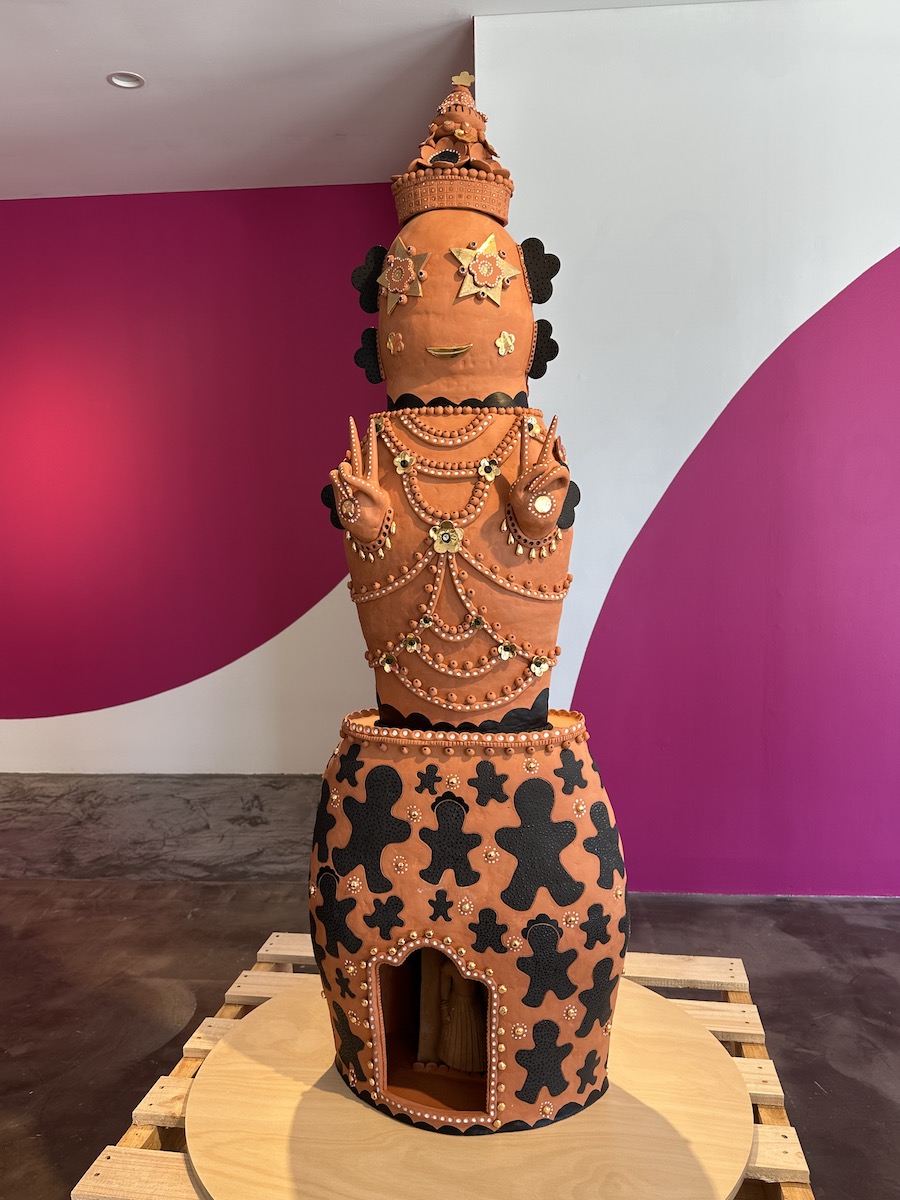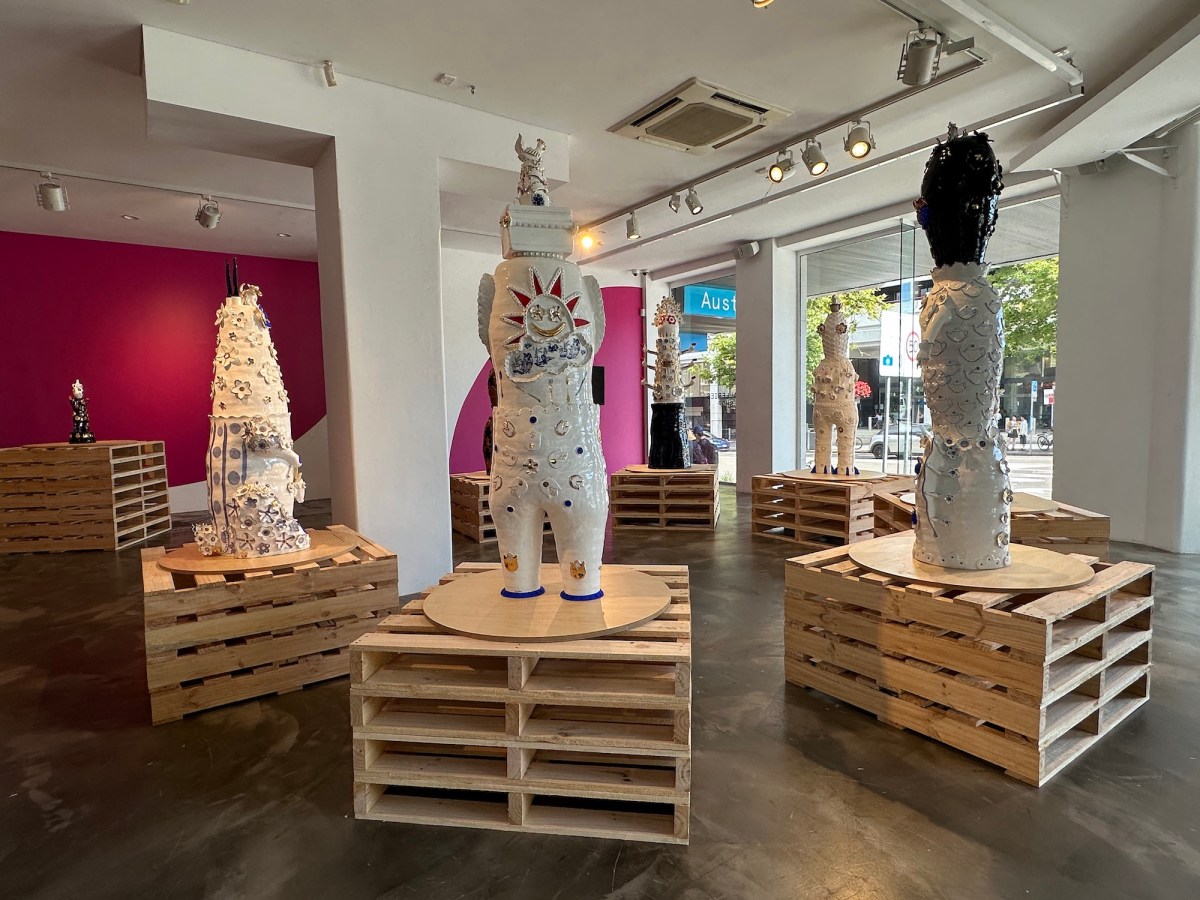re/JOY is pure joy. The largest body of work to date by Thai-born, Melbourne-based ceramic artist Vipoo Srivilasa, re/JOY has opened at the Australian Design Centre (ADC) in Sydney, before it tours to regional venues across five states, over the next three years.
The exhibition follows his receipt of the inaugural MAKE Award last year, presented by ADC; however, the idea for this show started much earlier. Srivilasa approached ADC in 2022 after a project – of the same title, re/JOY – that engaged the rural community of Warrnambool in Victoria by repairing their broken ceramics that had too much sentimental value to throw away.
For ADC, he has taken that literal bonding and repair of the object into a more metaphorical space, embedding seven cherished items into oversized, totemic-like deities. Each stands about 1.5 metres tall, and is the result of a public call-out for donations of broken ceramic objects that were personally significant, and held memories of their stories of migration.
These included a teapot made in Korea, a terracotta tile from India, a clay tree of life sculpture from Mexico, a studio production cup from Copenhagen decorated with cornflowers, grandmothers’ bowls from Shabbat dinners in the UK to healing Chinese soups, and a carved plate from El Salvador. They hold the precious memories of donors like Sultana, Emiliano, Jooyun, Lene, Becca, Cyrus and Rebeca.
However, Srivilasa is not interested in just conveying their stories in clay. Rather, these objects become triggers for a broader connectivity, and we get a hint of that in the arrangement of the pieces.
Stephen Goddard has worked with Srivilasa on the exhibition design, placing each of the Srivilasa’s sculptures atop a stack of raw shipping palettes – their very medium pointing to the transience of migration, and the foundational role that those stories hold when these individuals are uprooted, and how they frame, or describe, themselves and home.
The sculptures are arranged in a circle – not unlike a welcoming circle or a sharing group (or a group therapy session) – and convey a warmth. They each look inwards, holding the group as one, and in an open gesture to share.
A modest figure, in comparison, stands to the side, slightly self-deprecating at half the size, and out of the lights. It represents Srivilasa in this group dynamic, and it carries a button of his grandmother, strung as a pendant and hovering over the heart.
Overall, it is a simple exhibition in many ways, and yet it is enormous in its technical complexity.
Browsing the publication that accompanies the exhibition, one is reminded just how prolific and consistent – or singular – Srivilasa has been in his visual language over the past 25 years. It is surprisingly tight, even narrow one may say, but it is a genuine pursuit.
This exhibition continues that persistent decorative thread, and Srivilasa’s signature palette of cobalt blue, gold and lustres. He again falls back on the use of flowers and traditional Thai dance gestures, which he has used across his oeuvre. Scale is the major new front with these works.
One piece that steps outside the stylistic leash hold is a terracotta figure, Sultana – Goddess of Independence. It is the first time he has moved to work in this medium, and he has used its very materiality to connect with a broken terracotta tile from India.

Looking across the exhibition – and consistent with his smaller scale pieces – Srivilasa’s figures are impeccably made, and resolved. It is not surprising given his studio practice, which is pristine and driven by routine. As Alice Pung quotes him in the exhibition publication, “I keep a vacuum next to me, and every hour or two I clean.”
Read: So you want my arts job: Ceramic Artist
Pung also reveals that Srivilasa keeps a gratitude journal, and has a dogged determination to be content. For Srivilasa, who generously supports the practice of others, community is almost as important as studio practice itself.
While essayist Glenn Barkley warns that “community is a term that is overused so much that it has become corrupted and rendered useless [today]”, in Srivilasa’s hands it remains genuine, even when it is laden with humour, or parody. The blend of self and others is selfless, and is a reminder to pause and listen.
These are much more complicated sculptures than they initially appear, and draw out complex conversations about relocation in a contemporary Australian context.
They make for a perfect exhibition to tour regional Australia – to broaden thinking around the medium of ceramics, and encourage generosity and acceptance of a culturally diverse Australia.
re/JOY
Australian Design Centre, 101-115 William Street, Darlinghurst, Sydney to 19 February 2025.
The exhibition will tour Australia from 2025 to 2027.
Vipoo Srivilasa was awarded a $100,000 VACS Commissioning Grant from Creative Australia for this project with ADC as the commissioning organisation.





_Encounters-in-Reflection_Gallery3BPhoto-by-Anpis-Wang-e1745414770771.jpg?w=280)